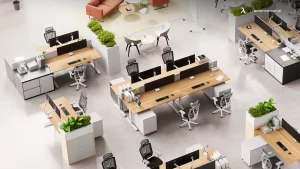Biophilic Furniture Trends: Integrating Nature Into Interiors

Ever walked into a room and instantly felt calmer? Chances are, it had something to do with natural light, wood textures, or maybe even a living wall. That’s biophilic design at work—bringing the outside in. And right now, furniture is leading the charge.
Why Biophilic Furniture? The Human-Nature Connection
We’re hardwired to crave nature. Studies show that spaces with natural elements reduce stress, boost creativity, and even improve air quality. But let’s be honest—not everyone can live in a treehouse. That’s where biophilic furniture steps in. It’s not just about adding a potted plant (though that helps). It’s about design that mimics organic shapes, materials, and patterns.
Top Biophilic Furniture Trends Right Now
1. Live-Edge Wood Tables
Raw, unfinished edges that follow the tree’s natural contours. These pieces feel like a slice of forest in your living room. Popular woods? Walnut, oak, and—for the bold—spalted maple with its wild fungal patterns.
2. Furniture With Built-In Planters
Bookshelves with integrated herb gardens, coffee tables that double as terrariums. It’s functional greenery without the clutter of extra pots. Perfect for urban spaces where every square inch counts.
3. Organic, Curved Silhouettes
Say goodbye to sharp corners. Designers are leaning into fluid shapes that mirror river stones, mushrooms, even ocean waves. A sofa with rounded arms isn’t just stylish—it feels more inviting.
4. Sustainable and Upcycled Materials
Cork chairs, bamboo bed frames, lamps made from reclaimed driftwood. Sustainability isn’t a bonus anymore; it’s the baseline. Look for FSC-certified wood or brands using zero-waste production.
How to Mix Biophilic Furniture With Your Existing Decor
Worried it’ll clash? Here’s the deal: nature plays well with others. Try these combos:
- Minimalist + Biophilic: A single live-edge console against white walls lets the wood’s texture shine.
- Industrial + Biophilic: Pair metal-framed chairs with a woven rattan light fixture for balance.
- Bohemian + Biophilic: Go wild—layer jute rugs, macramé, and a mossy green velvet sofa.
The Psychology Behind Biophilic Choices
It’s not just aesthetics. Certain materials trigger subconscious reactions:
| Material | Effect |
| Wood | Warmth, comfort |
| Stone | Stability, grounding |
| Water features | Calm (even simulated ones!) |
Fun fact: A 2023 study found that offices with biophilic elements saw a 15% increase in productivity. Imagine what your home could do.
Budget-Friendly Biophilic Swaps
No need for a full redesign. Small changes pack a punch:
- Swap plastic side tables for vintage wooden stools.
- Drape a linen throw over your couch—it breathes like cotton but looks more organic.
- Use peel-and-stick wallpaper with fern or lichen patterns behind shelves.
The Future: Smart Biophilic Furniture
Tech is getting in on the action. Think:
- Desks with built-in grow lights for your succulents (and your vitamin D levels).
- Soundwave art that mimics rustling leaves when you walk by.
- Modular planters that attach to any furniture piece.
It’s not sci-fi—it’s already hitting showrooms in Copenhagen and Tokyo.
Final Thought: Less Perfect, More Alive
Biophilic design rejects sterile perfection. A knotted wood grain, a slightly uneven ceramic vase—these “flaws” are what make nature (and your space) feel real. Maybe that’s the real trend: embracing the imperfect aliveness of the natural world, one piece of furniture at a time.

